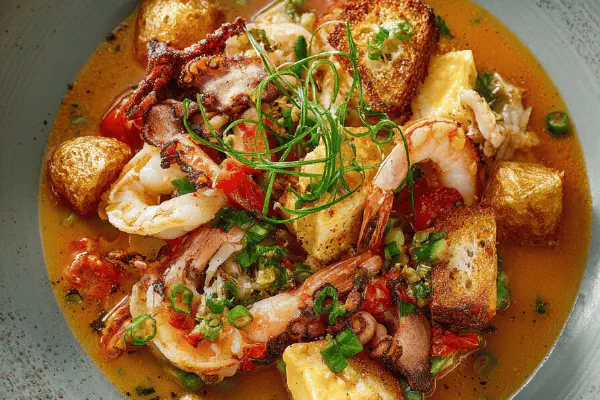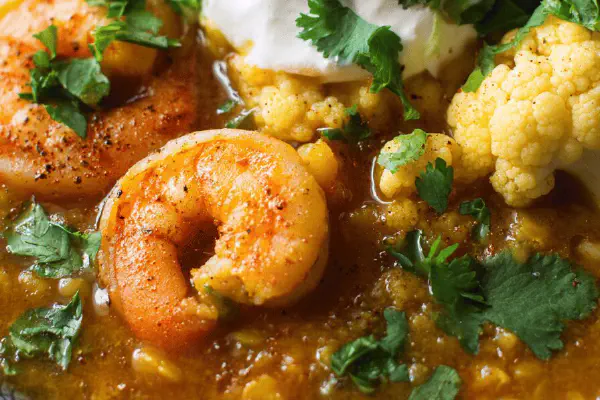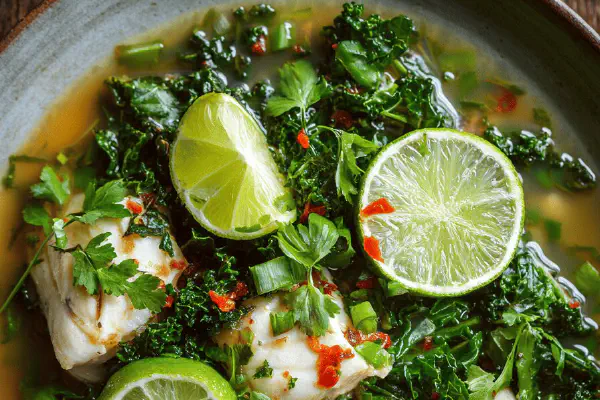Featured Recipe
Thai Chicken Shrimp Soup

By Kate
"
A hearty Thai-inspired soup merging tender chicken thighs with plump shrimp, fresh veggies, and fragrant aromatics in a creamy coconut broth. Rice cooks right in, soaking up flavors and adding body. Citrusy lemongrass and fresh ginger build layers while snap peas and carrots deliver crunch. Technique focuses on balancing textures, timing proteins just right, and coaxing maximum flavor from each step. Dairy-free, gluten-free, nut-free, and egg-free.
"
Prep:
15 min
Cook:
35 min
Total:
50 min
Serves:
4 servings
Thai
soup
seafood
coconut
Introduction
Cooking Thai-style soups is less about rigid timing and more about reading the ingredients. Chicken thighs—better than breast for flavor and keeping moist. Shrimp cooked too long turns rubbery. Rice absorbs coconut milk and broth to thicken the dish; get it right or texture falls apart. Aromatics like ginger and lemongrass build complex layers—don’t skimp. Peas and parsnips add that crunch—texture contrast is key or it’s just flat soup. Fresh basil late in the game lifts the whole bowl. Balance heat to keep herbs fresh, shrimp tender, and rice creamy yet separate. Timing, heat, and ingredient order—it’s all a sensory dance.
Ingredients
About the ingredients
Swapped shallots for onions to get milder sweet flavor which complements chicken better during browning. Parsnips replace carrots for a sweeter earthy depth but carrots still work fine if you want sharper edge. Fish sauce added for depth and saltiness, a classic Thai umami bomb, but add sparingly to avoid overpowering. Use parboiled rice—it holds grains separate and absorbs liquid evenly without becoming pudding. Shrimp size affects cooking time—larger ones take longer but add meatiness; smaller ones cook fast but risk drying out. Fresh herbs—basil preferred for peppery, bright flavor, coriander offers citrus notes but can muddle with lemon grass if used fully.
Method
Technique Tips
Brown chicken with shallots in half the oil first—creates deep caramelization that builds richness. Don’t overcrowd pan or meat steams. Stir rice in coconut milk right away; coat grains fully for even cooking. Cover tightly so steam cooks rice, don’t lift lid or risk drying. Meanwhile, sauté aromatics fast on medium heat to soften but keep vibrant—burnt garlic or bruised herbs kill freshness. Use two pots to stagger cooking and avoid overcooking shrimp or veggies. Turn heat off as soon as shrimp turns pink. Add chili slices at end for heat and crunch without bitterness. Final assembly keeps rice base separate from broth—mix in mouth, not pot. Garnish with fresh basil just before serving for aroma hit.
Chef's Notes
- 💡 Start raw chicken thighs in hot oil; get that crisp without steaming. Watch for browning. Keep stirring rice in coconut milk mixed, coat each grain. No peeking, cover tightly.
- 💡 Adding fresh aromatics fast; garlic should not turn dark brown. Adjust heat to keep greens bright. Final minutes, keep an eye. Pink shrimp? Remove quickly—texture overcooked goes rubbery.
- 💡 Consider using lime zest if lemongrass unavailable—it brightens flavors too. Can use green beans instead of snap peas but adjust cooking time. Carrots work fine, cut small for crunch.
- 💡 Final assembly—bowl rice then ladle broth over. Keeps textures apart. Basil at end for aroma boost. Missing basil? Coriander isn’t bad. Go for fresh herbs; that’s key.
- 💡 Extra creaminess? Toss in coconut milk off heat. Boosts silkiness. Watch the simmering. Gentle bubbles only; big means boiling too hot. Timing on heat—key for good soup.
Kitchen Wisdom
How to know shrimp is done?
Look for pink and curled shape; no longer translucent. Take out immediately; overcooking is rubbery. Timing is crucial.
Can I store leftovers?
Yes but be mindful. Broth keeps in fridge; rice may swell and absorb liquids. Store separately if possible; reheat gently.
What if my broth turns salty?
Try adding more stock or water to balance. A bit of coconut milk can help too. Taste test often; avoid surprises.
Is there a substitute for parsnips?
Carrots work, but cut smaller. Otherwise sweet potatoes are good too. Each changes sweetness; think about texture.



